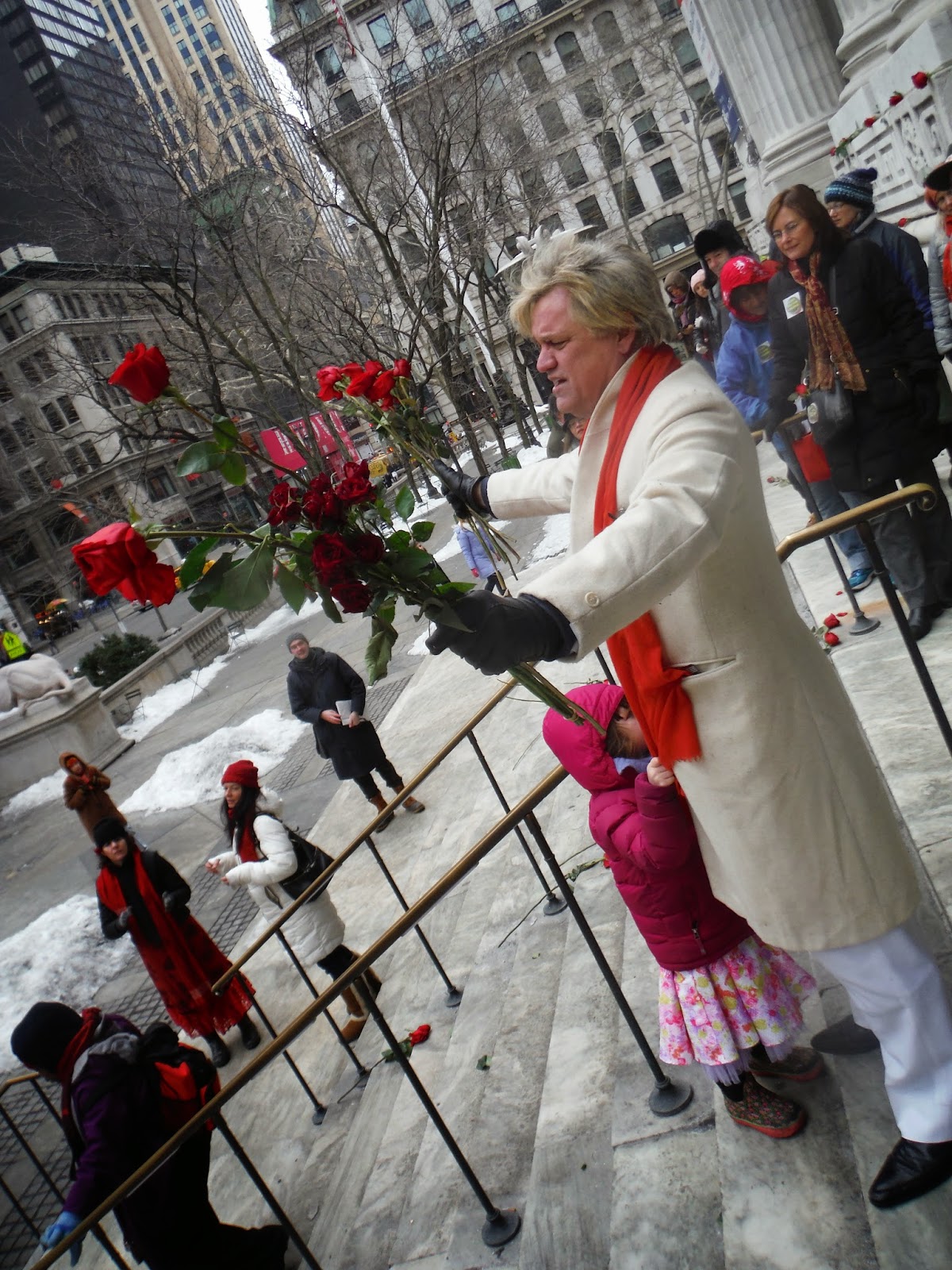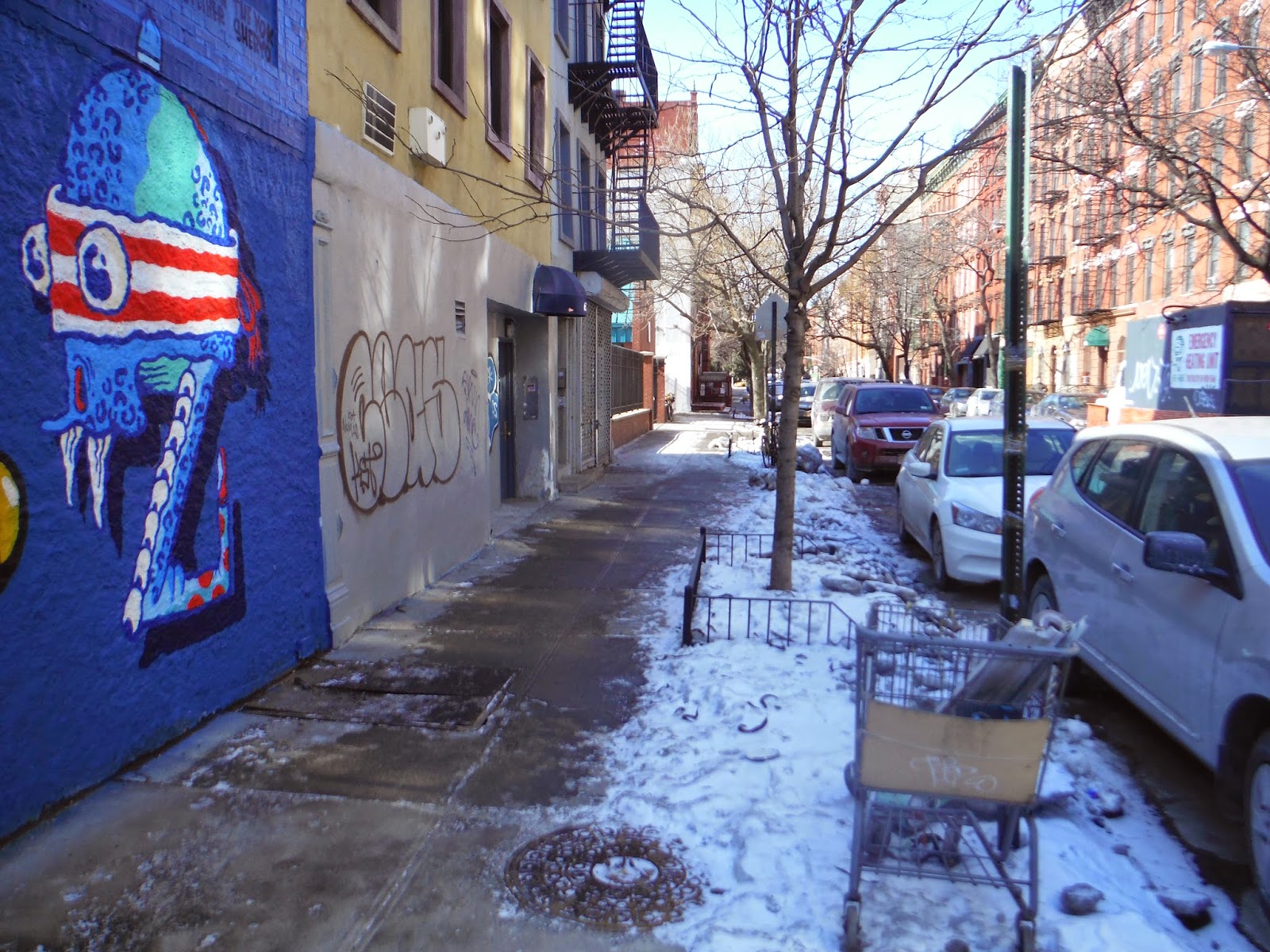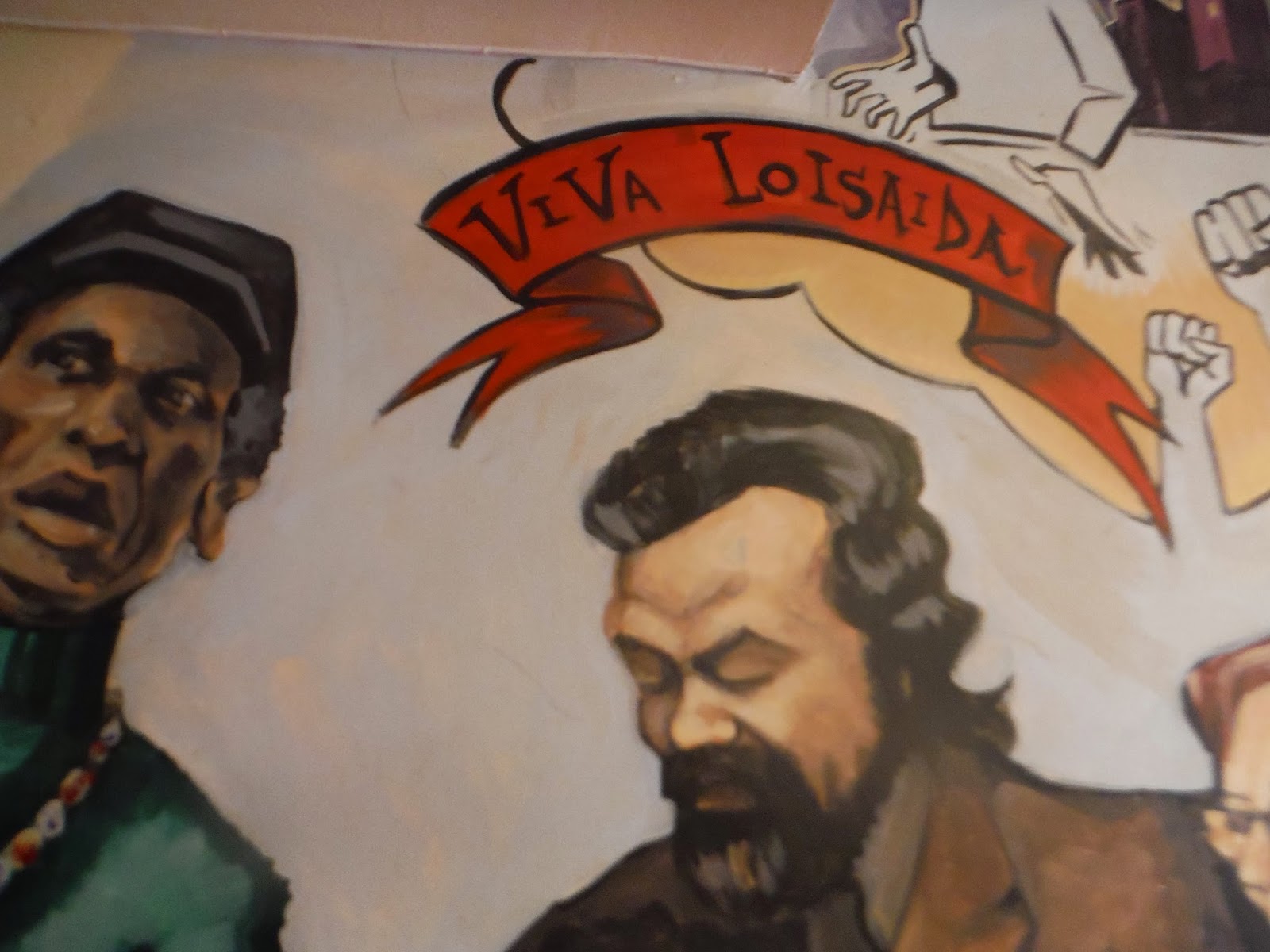 |
| kenny scharf |
 |
| Saturday, we defended the library and looked at what the city had to offer. |
Throughout the winter, the
stories of our lives here churn between art, books, thoughts and public spaces we enjoy and are support by in the city.
All weekend we defended and reveled in these vital spaces. This summer, I talked with Adam Purple about
the community gardens. He spend much
of the interview speaking about libraries as public spaces, full of gems and treasures, mysteries and insights much like his Garden of Eden. These things overlap in my mind, our need for gardens and
libraries, art and trees. Friends and spaces where we can think about our lives and communities, the art we love and the stories which bring us here. Yet, they need support. In the same way a car can mow down someone walking in a public street, the private can consume the public, as our commons, our gardens, libraries, and stories, are bulldozed by the privatizers. It is up to us to keep them alive. And so we do.
Friday, we made our
way through the cold to Greenpoint to catch up with friends and eat perogies.
At dinner, we talked
about the gardens and the tired false dichotomy between gardens and
affordable housing. We need both, of
course. We need both. That was the lesson of the Lower East Side Collective. Gardens are not getting in the way of
affordable housing we argued back in 1999.
Its been the same argument ever since. But the city keeps pulling out
the conflict when it wants to justify bulldozing green space.
The story about Esperanza community garden
was on my mind all weekend long, as we contemplated the 15th
anniversary of its loss, as well as the other gardens still on the chopping
block today.
Saturday on
Valentines, I tweeted out:
Remember Esperanza,
bulldozed 15 years ago.
#deblasio #dontberudy HPD take the 17 gardens off your RFP list.
My friend Kerstin Mikalbrown wrote one of the best
stories about the garden in our book From
ACT UP to the WTO, “Saving
Esperanza Garden: The struggle over community gardens in New York City.”
The Esperanza Coqui
Walking down my street, I sometimes get the
feeling that I don't belong. Between all the concrete paths and advertising
billboards, genuine contact with other people often slips through the cracks.
I eat in private — whether at home or at secluded tables in restaurants. I
live with one roommate who I hardly see. And I when I go to work, I sit in a
cubicle, by myself. Ironically, I am not alone in this. Being alone is par
for the course in most large urban centers. In fact, it seems that cities are
more and more designed for people to live very alienated lives. New York City
is one of them. There are almost no
public spaces in this city. Socializing is based around cafés, bars,
restaurants, and shopping — private spaces where you need to pay a fee (whether a cup of coffee or drink) to
stay. They are commercial spaces designed to make a profit. And if you
cannot afford endless four dollar cappuccinos or seven dollar drinks, you
find yourself with not a lot of places to go. Even the public parks — which
are there are not many of — are full of venders, fences, and curfews. And I rarely have an encounter
with someone else in the park.
That's why I was amazed to find myself sitting in
front a campfire in a garden in the middle of Manhattan one night this
winter, surrounded by strangers who were talking to me as though I were
sitting in their own kitchen. The
garden was called El Jardin de la Esperanza, Spanish for "The Garden of
Hope." It was a community garden on the Lower East Side, a garden
created and enjoyed by neighbors. It was destroyed by the city of New
York.
We’d have a garden
reunion for those of us who took part in the defense of the space on Sunday. These gardens are places where we meet our friends and watch our communities take root. They are places to meet up. As Henry David Thoreau wrote:
I frequently tramped eight or ten miles through the deepest snow to keep an appointment with a beech tree or a yellow birch, or an old acquaintance among the pines.
But first Saturday,
a few of my friends from that old campaign were on hand to support the NYPL,
another piece of our public commons, the NY Public Library. We’d been talking about the commons all
week long.
This idea of a
pulsing commons where we meet to make art, hang out, and share our lives, this
first glance of what New York could be happened for me when I was a kid
living in Dallas, reading through Art After Midnight, a book about the Lower
East Side (LES) art scene. Here, punk
overlapped with graffiti, surrealism with the Jetsons, pop with AIDS activism
all pouring out of the streets into the gallery and back into the clubs and in between the corners of our minds. That’s what I thought when I looked at the Kenny Schwarf
Thursday, the city felt
like some of that spirit was alive between a book reading at Bluestockings
and the opening, All Together Different LES Art.
·
Lore would have it that the storied past of
the Lower East Side and East Village art scenes ended with gentrification in
the 90’s. But some of those very artists have stayed and continued making
art. This show is a survey of current Lower East Side artists — those still
engaged in a forever changing and a forever the same neighborhood; of those
still making art, all together, different.
A project of the Educational Alliance Art School @ Manny Cantor Center, ALL | TOGETHER | DIFFERENT brings together nearly 100 Lower East Side artists and arts organizations actively working in the community. Curator Linda Griggs. Curatorial Advisor Yona Verwer. On View February 12 - April 1 2015 Opening Reception | February 12, 2015 | 7-9PM | at Manny Cantor Center: 197 E. Bway Portraits by Steve Ellis in the "Ignited New York" photo booth, and extended, moody bass and percussion by Scott Williams and Eric Holzman.
Running into my friends at the show, it felt
like some of that world and promise I felt looking at art after midnight and the downtown
scene still felt real and alive. The art was pulsing and fun, thoughtful and
mysterious, opening questions, provocative interpretations, and alternative realities.
Saturday, we met at the NYPL to celebrate the libraries for Valentines.
WHAT: Citizens Defending Libraries, the Committee
to Save the New York Public Library and Reverend Billy and his Choir cry out
in concert about the ache in our hearts for our library losses
WHEN: Saturday, February 14, 2015, 12:00 Noon. WHERE: Front steps of the 42nd Street Central Reference Library, Fifth Avenue Between 42nd and 40th Streets, New York, NY, 10018
This Valentine’s Day we, as
library lovers and defenders, will gather to speak and sing of an ache in our
hearts.
This Valentine’s Day at noon we will gather on the steps of the 42nd Street Central Reference Library to tell NYPL and library administration officials that there is a hole in our hearts and that we miss the things we love and want them back, now. . . We will gather with Revered Billy and his fabulous choir who have two soulful songs about our library losses to send up to the heavens as we pray for the preservation and return of what we love: “You Don’t Update a Masterpiece,” and “Library Blues.” . . . We will bring ROSES, a rose apiece, to say that we miss our beloved ROSE Reading Room, closed since flowers bloomed last May when the Rose Reading Room was suddenly shut down.. . . . . We miss, and ache for the return of ALL our books, ALL the books that library administration officials have been removing from the libraries. That includes all the books that were spirited away during the Bloomberg administration, emptying all the millions of research books from the stacks under the Rose Reading Room, stacks intended to hold three million books and designed to support the Rose Reading Room literally and literarily, both structurally and as a matter of its core function and raison d’être. We miss all the books that have been spirited away and not returned to other libraries including the books of other NYPL libraries and those of Brooklyn. And if the libraries had not been intentionally starved of funds in recent years as years estate deals to sell them were conceived there would be more books in Queens too. Where are the books that once filled our demolished Donnell? The books of the sold-off 42nd Street Annex? The more than one million books once found at SIBL, the Science, Industry and Business Library are mostly gone now and the few books that remain leave its public shelves so very empty. Our hearts ache for the empty shelves in children’s section of the Brooklyn Heights Library as the BPL tries to drive patrons away from another grand library, like SIBL, that library administration officials are thirsting to sell. What of the empty shelves and the books and bookshelves removed from Mid-Manhattan? We hope that we have truly fended off the plans to sell it, and the BPL’s Pacific Branch, so many other libraries that are in jeopardy, Red Hook, Williamsburg, Sunset Park, Clinton Hill . . . This list goes on and we must inevitably worry. When next Valentine’s Day comes we don’t want to find our hearts arching more for the loss of more libraries like SIBL and Brooklyn Heights. . . Here is some background about the closing of the Rose Reading Room and the elimination of its books: In a startling development in the saga of the NYPL’s plans for its libraries, the Rose Reading Room was closed last May when a chunk of its ceiling (previously restored and as part of a 1998 renovation) reportedly fell down in the middle of the night. Coincidentally, this happened in the window of time between when the NYPL was forced to abandon its plans for the consolidating shrinkage of the Central Library Plan (two weeks after) and its announcement (just four days later) that the Central Library plan would cost hundreds of millions of dollars more than the NYPL had previously publicized. Prior to this incident three million research books had been removed from the stacks beneath the Rose Reading Room. Upon closure even more books, all the books lining the walls of the Rose reading room were removed as well. The NYPL has said that it likes and will keep permanently in place the new more tortuous arrangements by which readers and researchers visiting the library must now obtain books, often with substantial delays as they are brought in from remote storage in New Jersey, if those books are successfully furnished at all. What’s worse: The NYPL has said that it eventually plans to return to the library only a fraction of the books it has removed! Heavens to Murgatroyd!: Just consider that it took the NYPL over eight months to erect scaffolding to start the inspection process. In the meantime, readers are crowded into small, poorly lit and ventilated rooms with ad hoc provision for computers. Last month a piece of the Gottesman Exhibition Hall's intricately carved Maurice Grieve ceiling collapsed, and it was then closed too.- We cannot help but worry: What do our library officials really care about? Think of all the books might be lost or damaged in the shuffle making them forever unavailable to readers who rely on the library? So we invite all library lovers and defenders to join us, Citizens Defending Libraries and the Committee to Save the New York Public Library as we gather with Reverend Billy and his choir to raise our voices in protest and songs that declare our love for libraries and books. . . Bring a rose to the event and we will leave a spray of roses of the steps of the 42nd Street Library signifying the hole on our hearts for the Rose Reading Room, the libraries and the books that we miss and want back now!!!
|
Sunday, we walked around the LES between on our way
to the anniversary gathering about Esperanza. It’s the gold standard for my
activism, because we were all invited in to take part in the campaign. We were all invited to take part in an ever
expanding, bountiful image of our community.
We talked about what Esperanza
meant and what we have to do to save the gardens under threat today.
 |
| JK pulled out my note to the Coqui from February 2000. |
 |
| images of the LES gardens and friends on a winter afternoon |
596 Acres posted a nice update on the gardens at
risk last week.
Last month NYC Housing Preservation and Development published a list of 181 City-owned properties available to developers for free to build new housing on. Seventeen active community gardens were included on this list without any consultation from the gardeners, the GreenThumb program, local City Council representatives or the community boards for the districts where the properties are located. We created a map and let all the stakeholders know how the list affected their gardens.
Our work helped get impacted gardeners, their neighbors, the New York City Community Garden Coalition and many many allies to the steps of City Hall on Tuesday morning asking Mayor Bill de Blasio to not give our land away. Council Members Antonio Reynoso, Robert Cornegy, Mark Levine and Manhattan Borough President Gale Brewer each wrote a letter asking for the gardens to be preserved and for our precious public land resources to be carefully considered before being given away (you can read the letters by clicking on their names). The New York Times covered the story and go the Mayor on record saying, "we’ll take a hard look at whether communities are best served by these gardens staying as they are. We’ll make those decisions in partnership with each community.”
Check out photos from the rally here and watch gardeners from Harlem Valley Garden and Patchen Community Square speak up on Brian Lehrer on CUNY TV! (That's a shot of the sound room at the bottom of this newsletter!)
Want to keep the momentum going to preserve the gardens on the #hpdlist? There are action steps on the New York City Community Garden Coalition web page. Write a letter to your council member! Email your borough liaison to the Mayor's office! And keep in touch with gardens at risk to ask how you can help!
Colin was at the meeting Sunday. He wrote a fantastic
summary.
Wary of a New Threat, Community Garden
Activists in New York Look Back
By COLIN MOYNIHAN FEB. 15, 2015
Aresh Javadi, left, of the
advocacy group More Gardens, at a gathering to remember a fight in 2000 to save
a community garden. Credit Victor J. Blue for The New York Times
One night 15 years ago, word spread across the
East Village: The bulldozers are coming.
The messages were referring to the Esperanza
Community Garden, a beloved but embattled patch of greenery on East Seventh
Street near Avenue C that the city had earmarked for development.
More than a hundred people barricaded themselves inside the garden that
night in an attempt to forestall its takeover. After 12 hours, some were
arrested and the garden was razed, even as lawyers argued in court to save it.
But hundreds of other gardens were eventually preserved in a legal settlement
that many said had been influenced by Esperanza’s destruction.
On Sunday afternoon, many of the people who
had rushed to Esperanza gathered nearby at the Sixth Street Community Center to
reminisce about those dramatic events 15 years ago. They also discussed
tentative plans by Mayor Bill de Blasio’s administration to build housing on up
to 17 city-owned sites where people had been allowed to establish temporary
gardens.
Photo
A photograph of Esperanza
Community Garden. Many who fought to save it in 2000 attended the gathering on
Sunday. Credit Victor J. Blue for The New
York Times
“Land has always been contentious,” said Aresh
Javadi, who was arrested at Esperanza and had helped found More Gardens, an advocacy group. “Our
neighborhood green spaces are just as important to us as Central Park and
Prospect Park.”
The debate over how to manage community
gardens in New York has stretched back decades, sometimes pitting community
activists and gardeners against developers and city officials who have sought
to sell garden parcels.
Officials have cited the need for affordable
housing, as Mayor Rudolph W. Giuliani did in 2000 when discussing Esperanza.
But advocates for community gardens have said that the housing built on former
sites is often expensive. Apartments in Eastville Gardens, the building that
replaced Esperanza, have been listed this year with monthly rent of between
$3,200 and $4,900, according to the real estate website StreetEasy.
The de Blasio administration, which has made
housing policy a priority, has said that any apartments built on temporary
garden plots would be “100% affordable” and has ruled out any market-rate
developments. Officials said the temporary gardens had been established with
the understanding that they might at some point be relinquished, but added that
the administration did not intend to build on gardens that had clear local
support.
“We’ll make those decisions in partnership
with each community,” Mr. de Blasio said in a recent statement.
On Sunday, as about two dozen veteran garden
advocates gathered and discussed tactics they had used years ago, some
considered dusting them off. One woman suggested that the city might not be
eager to tangle with them; another wondered whether there was a “wedge” that
could be used to dissuade garden development.
Photo
An online petition is asking
the city not to build new housing over the Jackie Robinson Community Garden in
East Harlem. Credit Victor J. Blue for The New
York Times
Many recalled the events that began on Feb.
14, 2000, inside Esperanza. Dozens of people spent the night around a smoky
campfire, and a few huddled inside a sculpture of a Puerto Rican tree frog, or
coqui, which was elevated on a wooden platform and had been used for weeks as a
tower to watch for takeover attempts.
The police arrived at dawn on Feb. 15, sealing
off the block, then scattering many protesters and arresting about 30. At the
same time, lawyers for the state attorney general’s office, then headed by
Eliot Spitzer, sought a State Supreme Court injunction forbidding the sale or
destruction of gardens.
Protesters who had locked themselves to fences
or chained themselves to buried blocks of concrete tried to delay the takeover
of the garden long enough for a ruling. But by the time Judge Richard D.
Huttner issued a preservation order for 174 other gardens, Esperanza had been
destroyed, with flowering plants, trees and the coqui sculpture crushed by a
backhoe.
One man, Mario Mazzoni, remembered the police
using a circular saw to cut him free from a block of concrete. “When I started
feeling the sparks from the saw,” he said, “I thought it was the blade cutting
into my hand.”
After the destruction, some criticized the city’s actions. State Democrats announced that the site’s developer, who had been chosen without
competitive bids, had donated $32,000 to Mr. Giuliani.
There were no further bulldozings of
established gardens. And in 2012 the city settled litigation by selecting about
150 gardens for development and agreeing to protect about 500.
On Sunday, as people discussed Esperanza, they
consoled themselves with the thought that their unsuccessful battle to save one
garden had helped preserve others. Jessica Torres, whose grandmother, Alicia
Torres, started the garden in the late 1970s, remembered watching a television
news report of the bulldozing.
“It was hard,” she said. “But then I thought
everyone from that garden would feel unity for a long time.”
 |
| and a wintery journey home. |
























































































































































Thank you!
ReplyDeleteThank you!
ReplyDelete